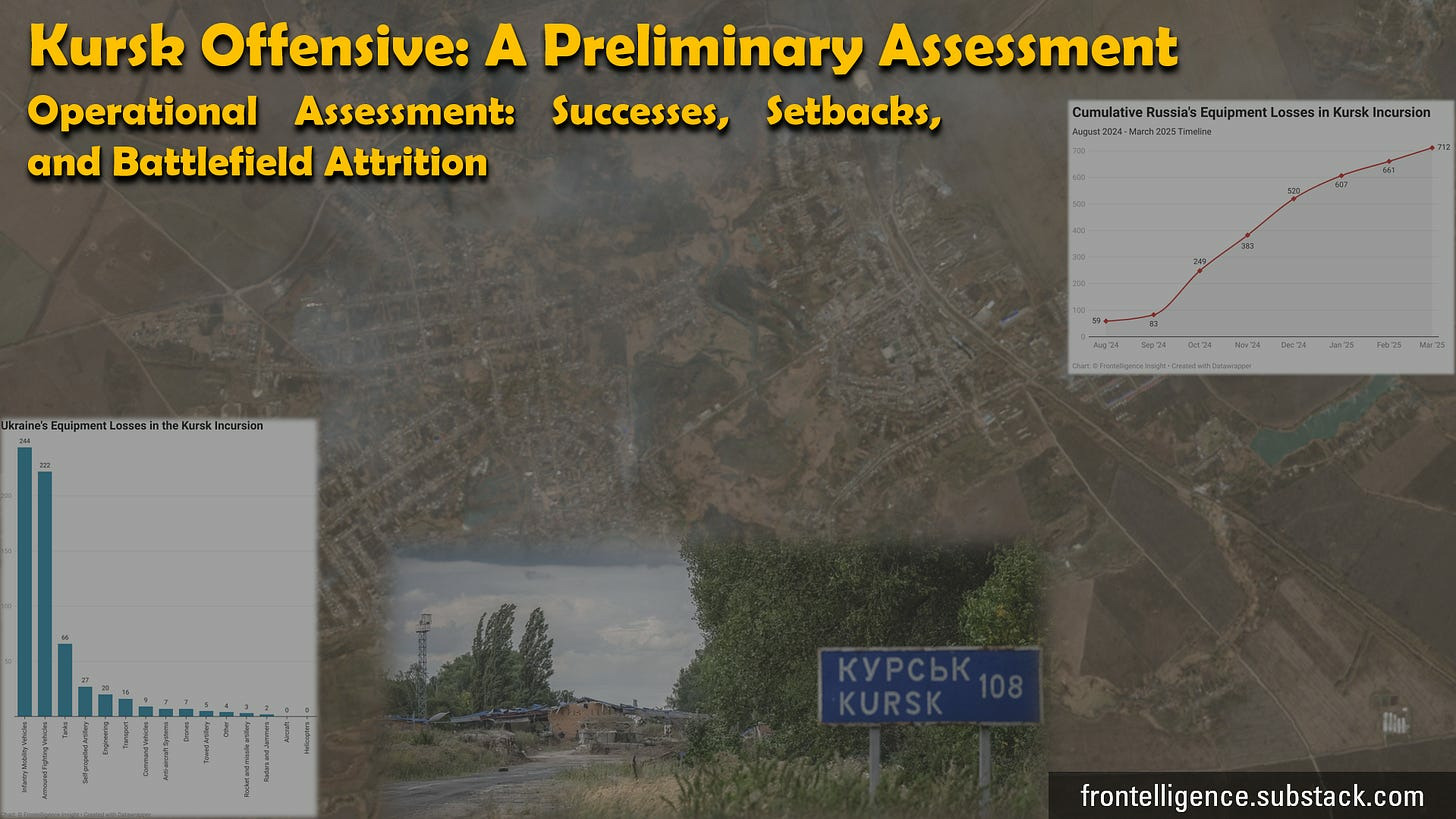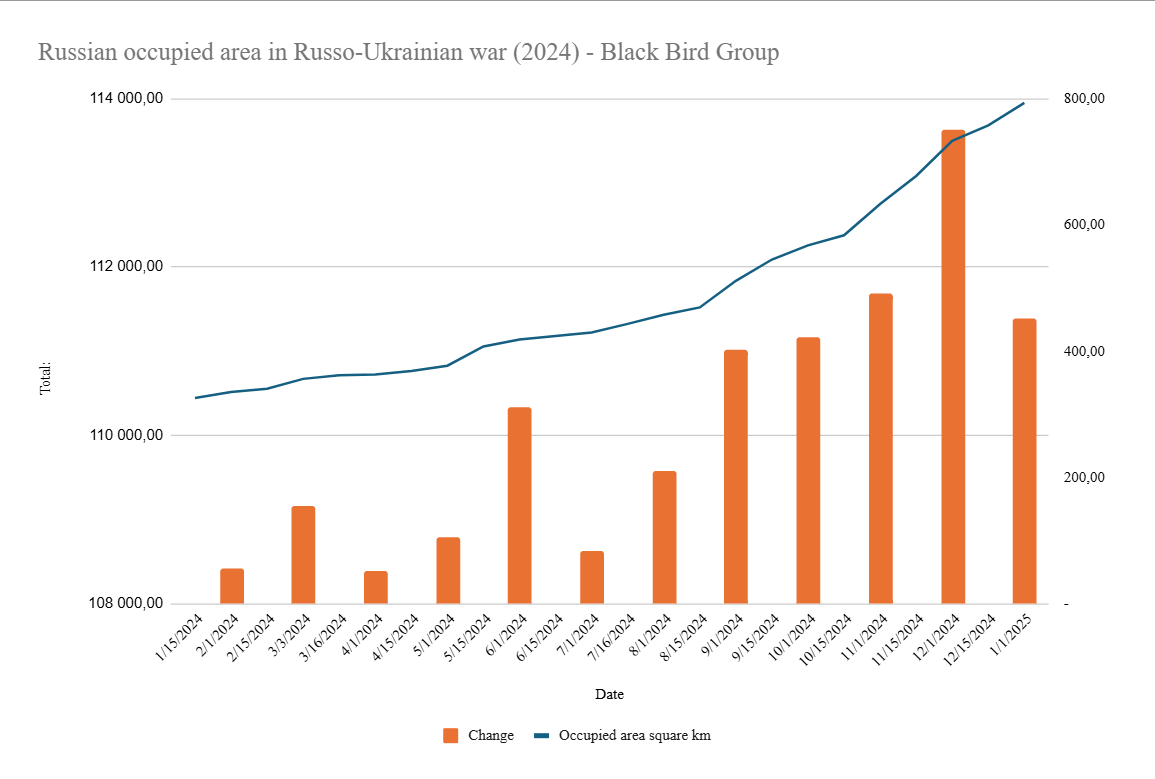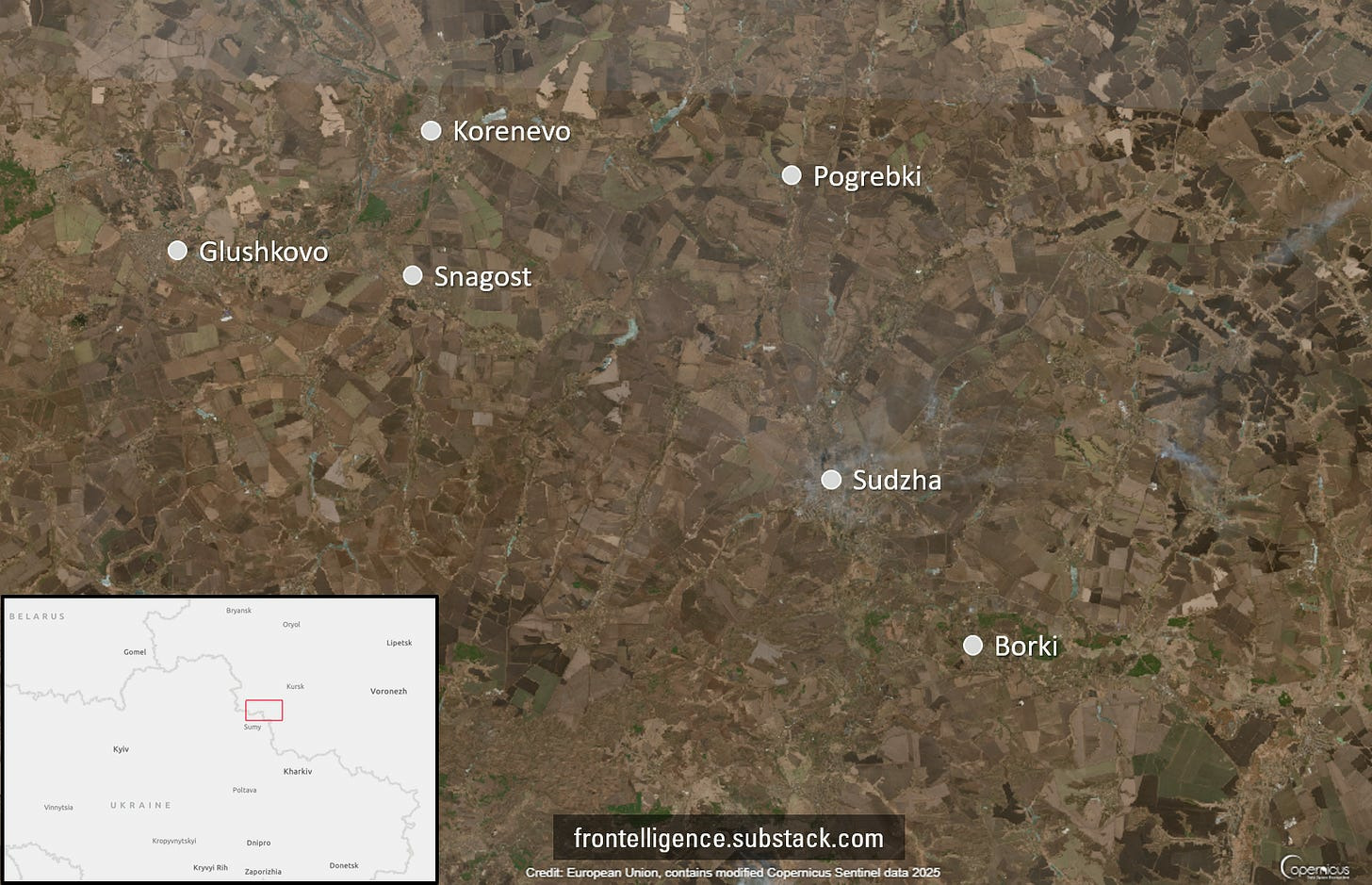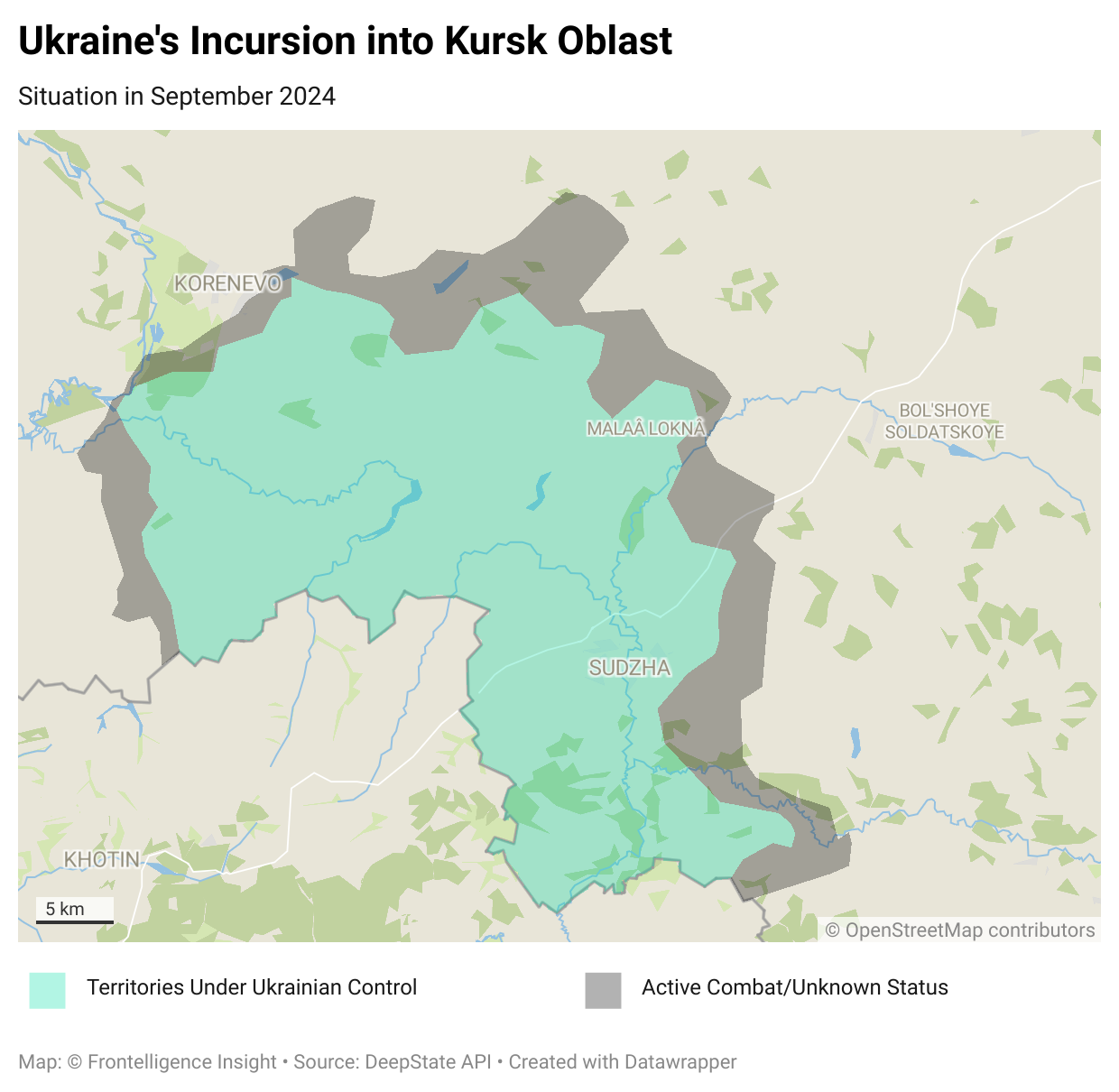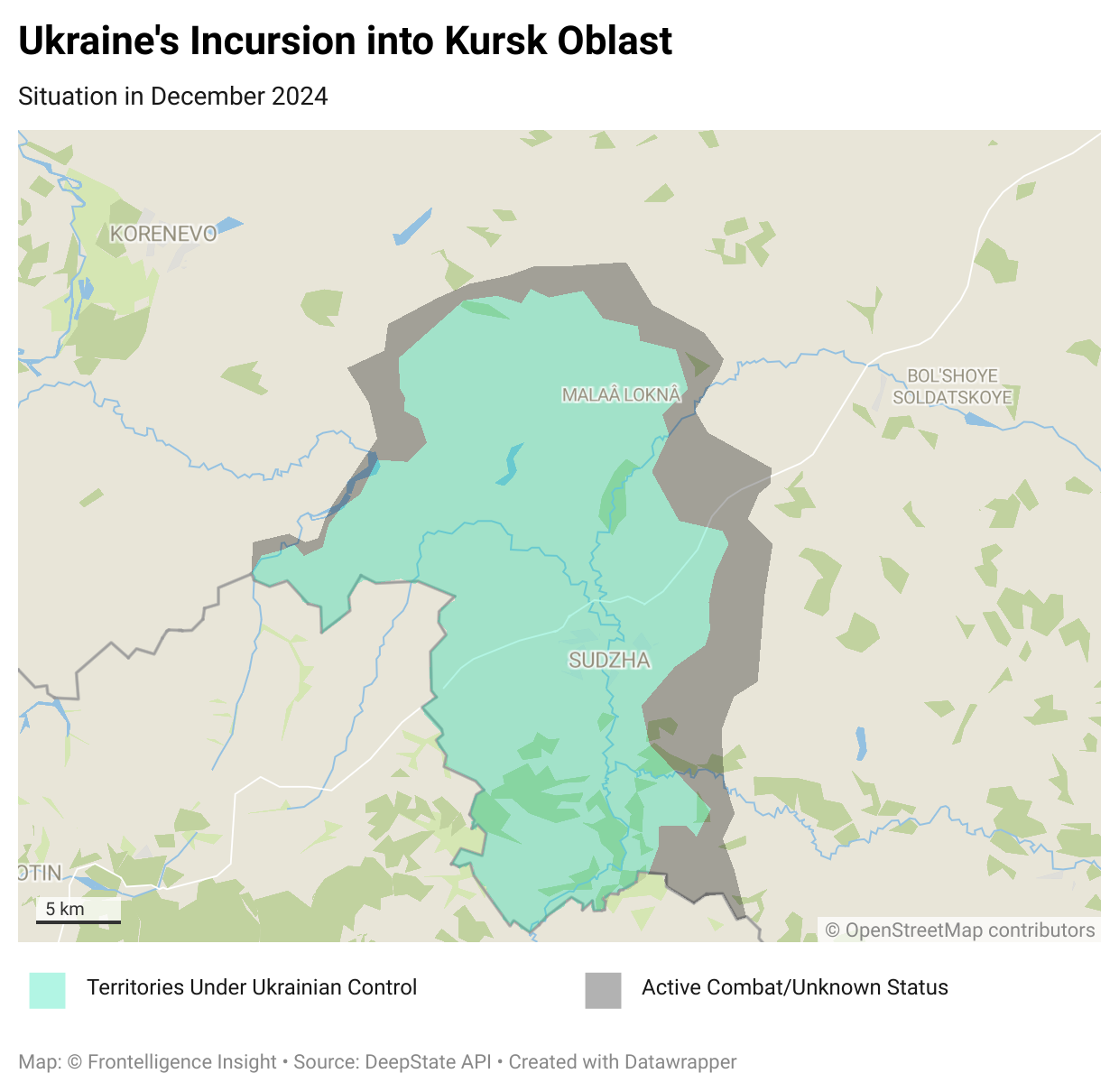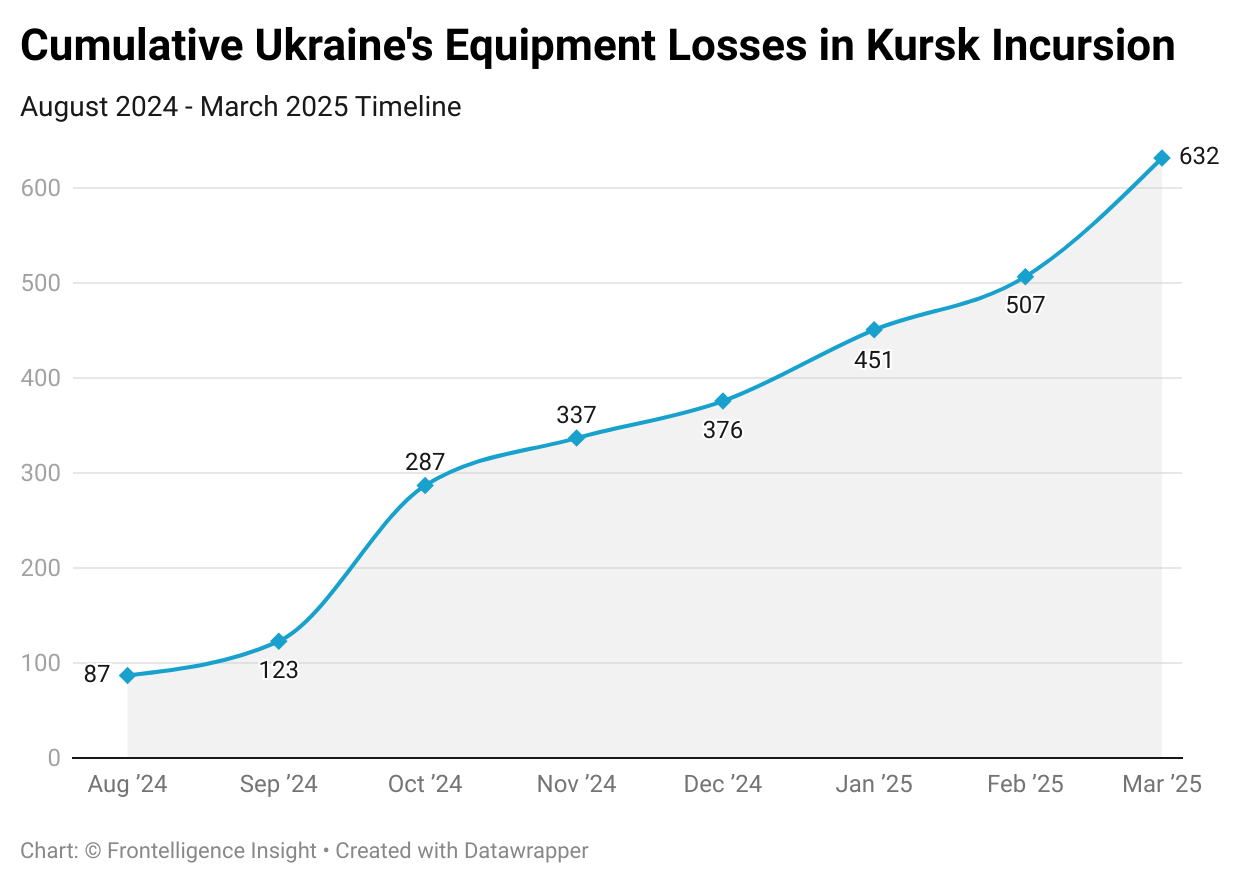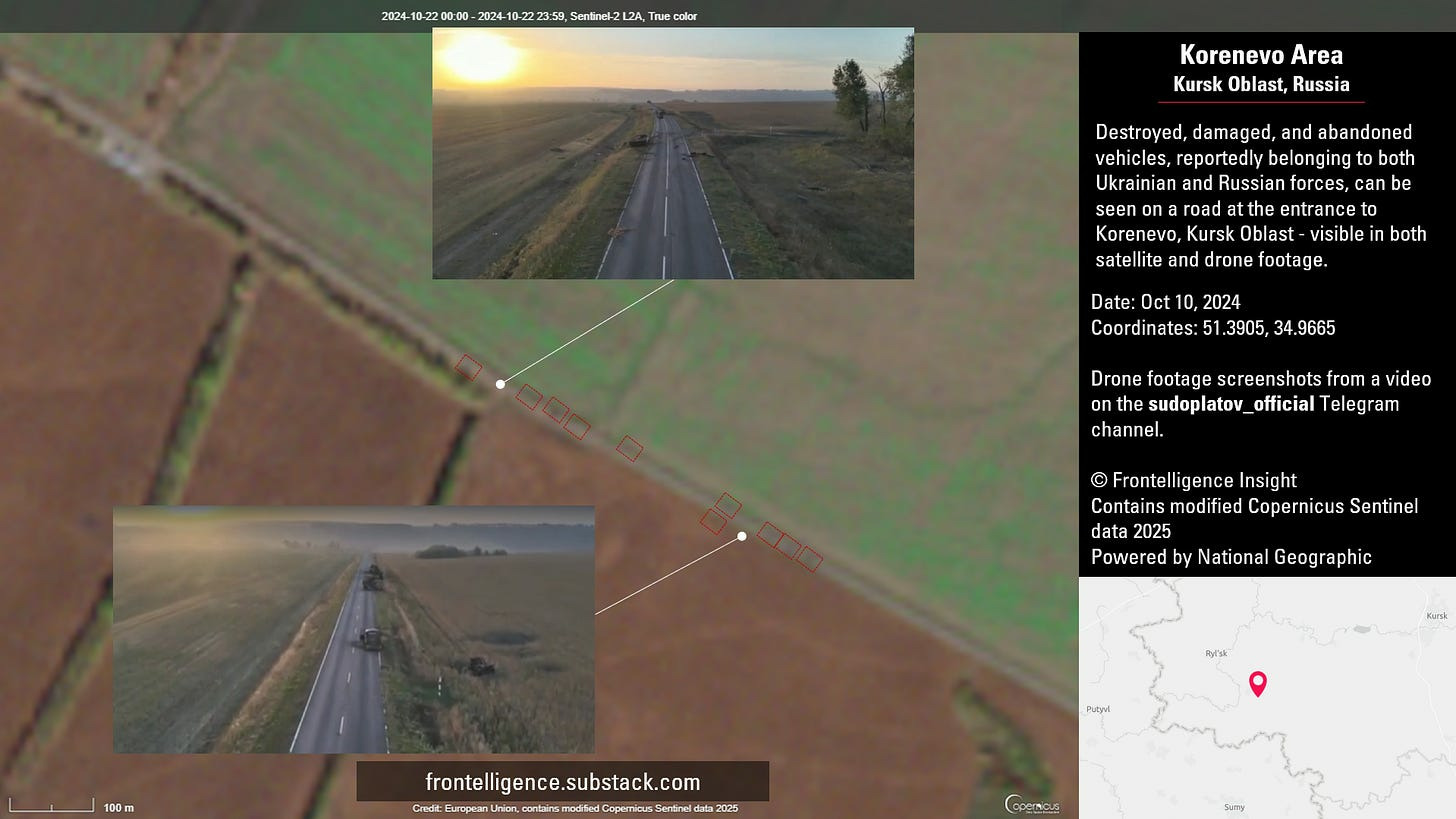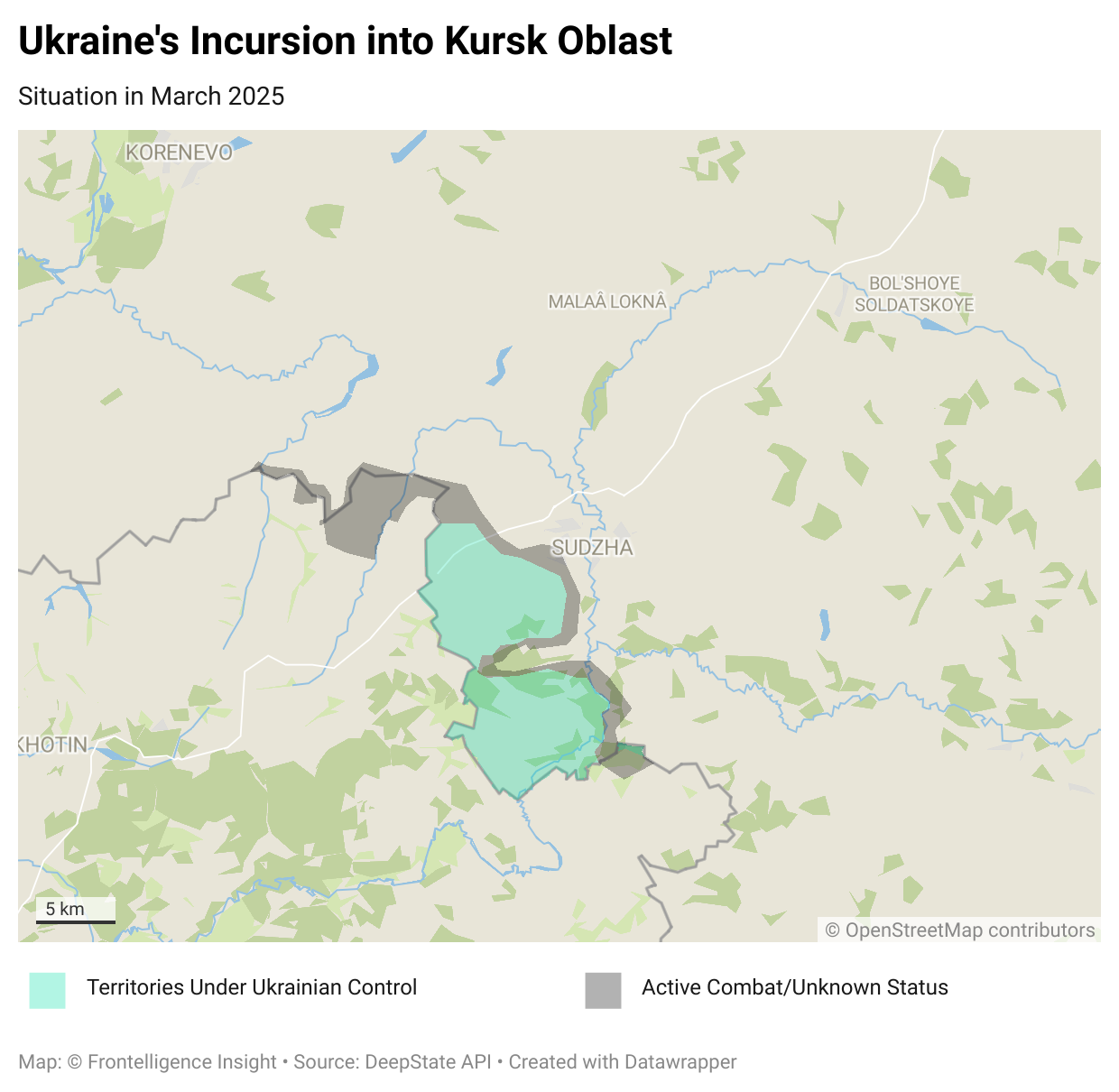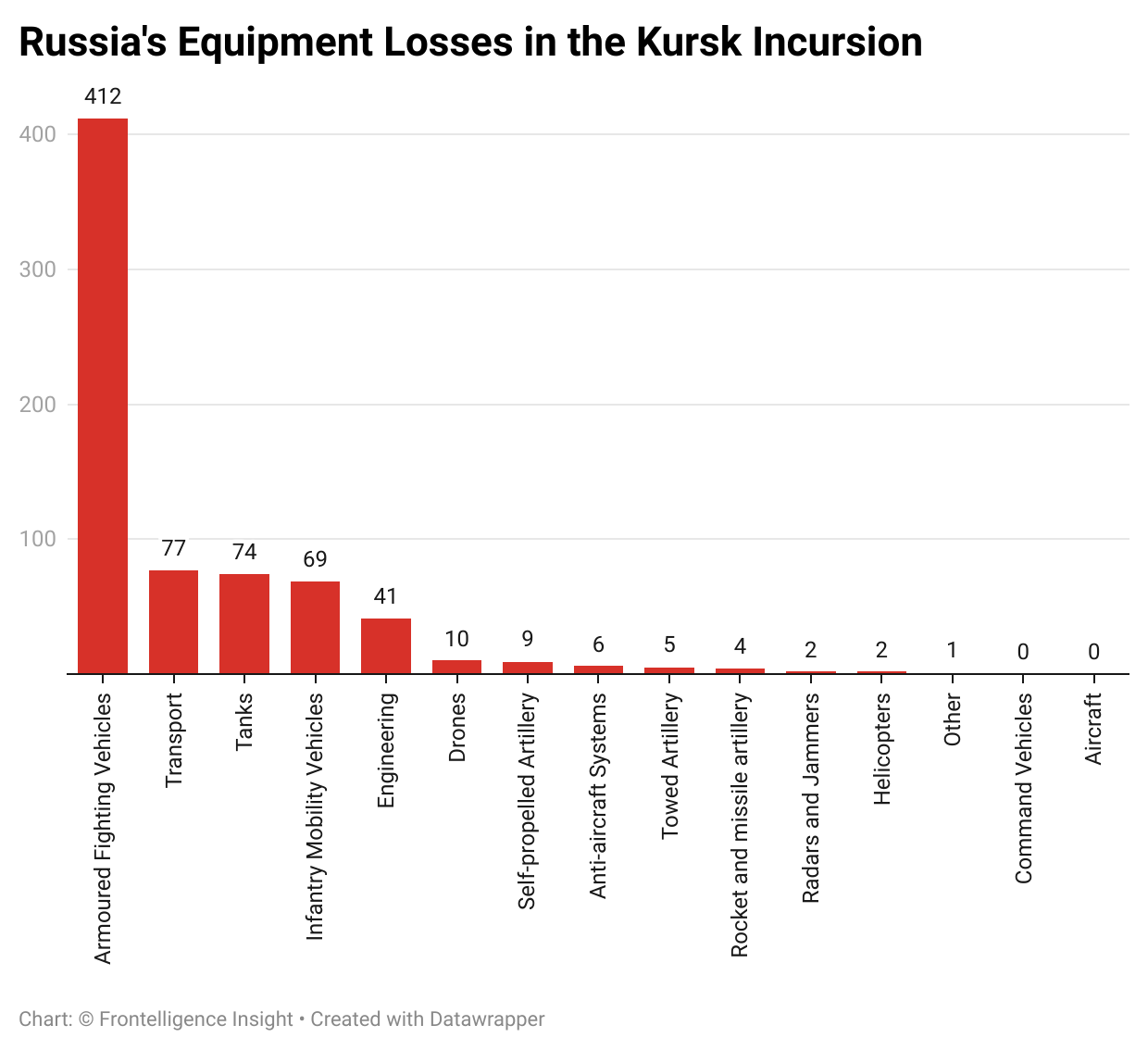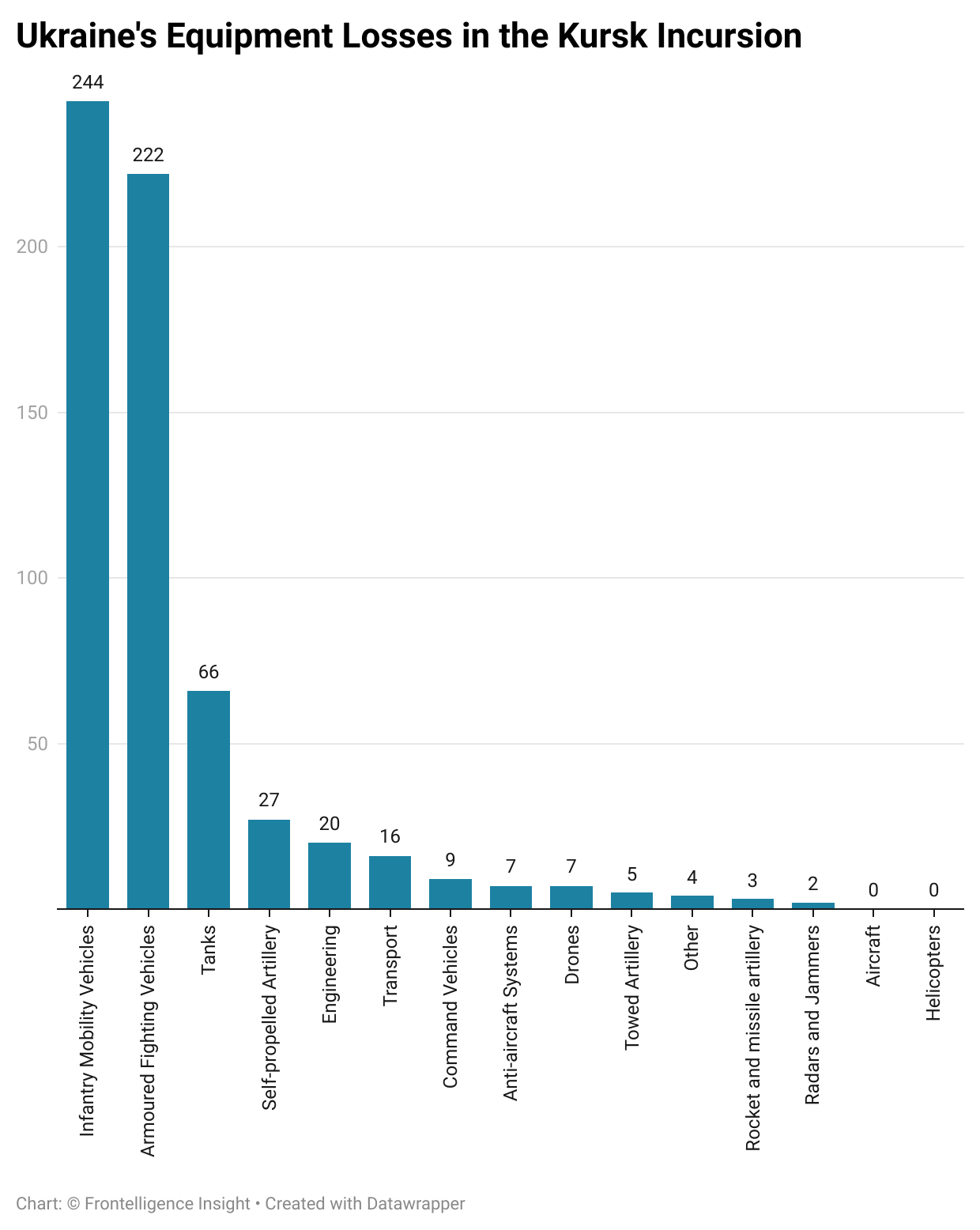Table of Contents:
I. Goals
a) Declared Objectives
b) Unstated and Secondary Objectives
II. Operation
a) Initial Phase
b) Main Phase
c) Concluding Phase
III. Attrition
a) Russia’s Equipment Losses
b) Ukraine’s Equipment Losses
IV. Summary
With Ukrainian forces withdrawing from Sudzha, the operation is clearly nearing its conclusion - though this is far from the end of the story. Given the ongoing speculation and discussions about the operation's success, we wanted to offer a clearer perspective on the matter. To answer this question, our team has broken down the Kursk operation into three key components: whether the geopolitical goals were achieved, whether the attrition rate was favorable, and whether the operation succeeded from a military standpoint.
This analysis focuses on verifiable data, including vehicle losses, captured territory, and stated operational objectives that can be assessed as either achieved or not. It does not cover the economic impact of the operation.
The analysis indicates that, overall, the operation fell short of achieving most of its stated objectives. The attrition rate was generally unfavorable for Ukraine, though certain aspects of the operation proved successful. This analysis remains preliminary, as the operation is still ongoing, and battlefield conditions could potentially shift in ways that significantly impact the assessment.
I. Goals
Different goals were put publicly by different Ukrainian officials. As the operation progressed and certain goals became clearly unattainable, officials redefined the objectives. This constant shifting of goals makes it difficult to determine the true goals of the operation. However, this isn’t unusual in this war - beyond statements meant to mislead the enemy, both sides have repeatedly adjusted the public goals of an operation when it became clear that the original objectives were unachievable, framing whatever progress was made as the intended outcome. To better determine the operation's actual objectives, our team analyzed early statements from officials and interviewed multiple participants of Kursk operation to assess whether the announced goals differed from the real one.
a) Declared Objectives:
Diversion of Russian forces from the Pokrovsk and Kurakhove sectors – as stated by Commander-in-Chief Oleksandr Syrskyi in August 2024;
The operation in Kursk Oblast aims to create a buffer zone disrupt Russia’s attempts to seize Sumy – as stated by President Zelensky in August 2024;
Holding territory as leverage for negotiations - part of the broader "Victory Plan” - stated by President Zelensky in September
1) Starting with the first point, it’s clear that the objective was not achieved, primarily because the units engaged in the Pokrovsk and Kurakhove operations remained in their respective operational zones and were not redeployed to Kursk. The only exception was the 810th Naval Infantry Brigade, which had only briefly been in the Pokrovsk area before moving to Kursk.
On the other hand, when Ukrainian defenses began to falter in the Pokrovsk direction in August, there were no reserves available to halt the advancing Russian forces. As a result, Russian troops secured significant territorial gains, which accelerated further in the fall as Ukrainian defenses faltered with no reinforcements to stabilize. While Ukraine’s setbacks were largely due to poor coordination, disorganized command structures, and flawed troop deployment, the inability to muster and deploy reserves also played a significant role, allowing Russian forces to advance rapidly.
2) The second point - preventing a Russian invasion from Kursk and denying a foothold for advances into Sumy Oblast. In this regard, Ukraine achieved some degree of success by creating a buffer zone inside Russian territory. This could have potentially deterred incursions into Sumy, much like how Russia’s earlier incursion into Kharkiv Oblast enabled the occupation of Vovchansk and Hlyboke areas.
It remains unclear whether Russia had a concrete plan to invade Sumy oblast. When Ukrainian forces entered Kursk Oblast, they primarily encountered border troops, conscripts, and weak motor rifle units assigned to rear-area security. Their weaponry was mostly light, suggesting there was no significant concentration of forces capable of launching a serious incursion at that time, nor was there sufficient equipment for such an operation. However, this alone does not rule out the possibility that such an offensive could have been planned for the future. In that sense, the operation can be considered successful if it preemptively disrupted any future Russian plans for an invasion.
3) One of the most frequently stated goals was political and diplomatic: the idea that controlling territory in Kursk Oblast could provide leverage for potential land swaps in future negotiations between Kyiv and Moscow. The logic behind this was sound: reclaiming large occupied areas through counteroffensives would be far more costly for Ukraine than seizing lightly defended Russian territory that could later be traded. This was one of the strongest arguments in favor of maintaining a presence in Kursk.
The fundamental issue was that Russia was unlikely to agree to a territorial exchange, and negotiations would not advance until Russian forces had expelled Ukrainians from Kursk Oblast.
As of this writing, Ukraine has lost or withdrawn from most of the territory it previously controlled in Kursk, significantly weakening its leverage. Given this, the political and diplomatic objective can reasonably be considered a failed goal.
There is, however, an alternative argument that the incursion improved Ukraine’s geopolitical standing by demonstrating its continued willingness to fight and proving that not everything was going badly on the front lines. Kyiv had high hopes that its successes in Kursk would signal to Washington that Ukraine was not only capable of defending itself but also of carrying out raids into Russian territory without triggering nuclear escalation. However, Washington’s response was notably cold. Despite expectations, the U.S. did not grant permission for Ukraine to use ATACMS missiles to strike deeper into Russia. That approval only came later, in November, following the involvement of North Korean troops. Beyond the limited inventory, the overall impact of ATACMS was far less effective than publicly anticipated, largely due to Russian interception efforts and targeting choices.
It’s fair to say that the most significant shift in U.S. aid and foreign policy occurred with the new administration in the White House, as well as due to tensions and reactions in Europe to these policy changes. In this context, the Kursk operation played only a marginal role.
At the same time, Russia used the incursion as an opportunity to introduce North Korean troops as part of its "de-occupation" effort. This allowed Pyongyang’s forces to deploy inside Russian territory without crossing into Ukraine, minimizing the potential international backlash that might have followed if North Korean troops had been stationed directly in occupied Ukrainian regions.
Overall, from a geopolitical perspective, the Kursk incursion has produced, at best, mixed results.
b) Unstated and Secondary Objectives
While previous goals were publicly stated and signaled, there were also objectives that were never officially acknowledged but were disclosed to our team in private conversations, as well as in discussions with other military analysts with whom we maintain professional connections.
According to anecdotal accounts from several Ukrainian officers, the initial military plan was far more ambitious, extending beyond Kursk and aiming for a push toward Belgorod oblast via Kursk Oblast. This maneuver would have effectively severed key logistical hubs critical to Russian operations. While our team has not seen concrete plans or documents confirming this, we cannot rule out the possibility that this was the original maximalist objective. If this was indeed one of the intended goals, then it is clear that it was not achieved.
Lastly, morale and recruitment remain important factors to consider. Since the beginning of the operation, numerous analysts, politicians, and war observers have argued that the success of the Kursk incursion provided a much-needed boost to Ukrainian morale, particularly in light of the series of setbacks the Ukrainian military suffered in 2024. Commander-in-Chief Oleksandr Syrskyi, in a September interview with CNN, stated that the operation "significantly improved the morale of not only the military but the entire Ukrainian population. That is, it was and still is an incentive that has boosted the morale of our servicemen, their desire to win."
This is a reasonable argument that can be supported anecdotally. However, there is no reliable way to quantify its impact or apply it to a structured model to determine a direct battlefield effect. As a result, any claim that the Kursk operation led to either significant battlefield success or no success at all due to morale gains remains speculative.
The only measurable factor we could assess was recruitment numbers. In Ukraine, there was no notable increase in recruitment following the operation. In contrast, Russia saw a rise in recruitment
II. Operation
Breaking the operation into phases offers a clearer view of how it developed and how each stage influenced the final outcome. This way, we can identify both missteps and successful moves without reducing the assessment to a simple “success” or “failure” binary assessment.
The opening phase of the operation, as assessed by our team, spans from July to September. During this period, Ukrainian forces were able to move, concentrate in staging areas, and enter Kursk Oblast, ultimately becoming contained within a defensive line stretching from Korenevo to Pogrebki, Martynovka, Sudzha, and Borki.
The main phase, spanning from September to February, is marked by active battlefield dynamics within the established frontlines. This period saw the introduction of North Korean troops and the gradual loss of captured by Ukraine territories.
Finally, the closing phase, beginning in February and extending into March, is defined by Ukrainian forces facing growing logistical problems caused by Russian pressure on them, leading to an operational Ukrainian withdrawal.
a) Initial Phase
Initial phase was the most successful part of the Kursk operation, yielding the highest returns in the operation:
The Ukrainian command correctly assessed the composition, strength, and firepower of Russian forces in the Kursk region;
Ukrainian forces successfully moved and concentrated near Kursk Oblast without their true intent being uncovered by Russian command;
The initial rapid maneuver into Kursk Oblast, beginning on August 6, allowed Ukrainian troops to bypass and flank Russian defensive positions, creating chaos and disorganization. This led to a significant number of Russian prisoners: ranging in the hundreds, including conscripts, despite Putin’s prior assurances that they would not be deployed in the war;
Relative to the territory gained, fortifications breached, and the number of prisoners and settlements captured in the first weeks, Ukraine sustained relatively low losses. Russia’s initial attempts to quickly deploy nearby reserves to halt the Ukrainian advance proved costly, resulting in higher casualty rates;
Ukrainian troops seized valuable intelligence, including classified documents and access to abandoned Russian systems, as many units in the rear had assumed they were operating in a secure environment;
There was a noticeable morale boost among Ukrainian soldiers, who had spent the previous months engaged in grueling, attritional battles that often ended in gradual retreats and territorial losses. For months, the predominant narrative had been one of Ukraine ceding ground, but the Kursk incursion shifted that narrative initially. This shift was not only domestic but also had international repercussions, providing the Ukrainian government with a brief diplomatic window;
Ukrainian command ultimately made a miscalculation, allowing a successful raid to evolve into a battle of attrition with increasingly diminishing returns.
b) Main Phase
The main phase saw a slow but steady deterioration of Ukrainian positions in Kursk. Fundamentally, the challenges Ukrainian forces faced mirrored those anywhere in Ukraine: Donbas, southern Ukraine or Kharkiv Oblast - compounded by additional issues unique to Kursk. These included operating in unfamiliar territory with foreign population, relying on a narrow logistical corridor, and lacking fortifications or pre-prepared defensive positions. While Ukraine successfully utilized fortifications abandoned by Russian forces, advancing deeper into Kursk Oblast required constructing its own defensive positions - a task that has been a consistent problem for Ukraine even on its own territory.
The early and prominent successes during the initial stages of the operation nurtured a misleading narrative that Russia was running out of reserves and combat-ready troops. In reality, countering an initial incursion of division size would have required time for Russia to mobilize and organize a response force at least twice as large to effectively contain and counter the Ukrainian advance. The early successes, while significant, fueled inflated and politicized expectations.
Once Ukrainian forces were contained by Russian reserves redeployed from across the country and other frontline sectors like Chasiv Yar and Zaporizhia, Ukraine gradually lost its initial advantages: mobility, initiative, and the ability to dictate the terms of engagement. As time passed, the Kursk operation increasingly resembled the grinding battles of Donbas, characterized by treeline assaults, rather than the fluid maneuver warfare seen in Kharkiv in 2022 or in Kursk during August;
The deployed Ukrainian forces varied significantly in combat readiness and preparedness. While some flanks were reinforced by elite Ukrainian air assault brigades, other areas, like some sections on the western flank, were held by less experienced units. This imbalance led to retreats and rapid territorial losses on the left flank during Russian counterattacks in the fall;
The prolonged Kursk operation successfully alleviated pressure on Ukrainian troops in certain frontline areas, like northern Kharkiv. The focus of Russian air-dropped guided bomb strikes shifted from Kharkiv to Kursk, and any potential Russian reserves that could have been used in Kharkiv were instead tied up in Kursk. This allowed Ukrainian forces to partially reverse earlier Russian gains in northern Kharkiv;
The redeployment of paratroopers from the 76th Division from the south likely contributed to delaying any potential large-scale Russian offensive operations in Zaporizhia. While it remains uncertain whether Moscow had concrete plans for a major assault in the south, at the time, the diversion of these elite forces to Kursk may have temporarily disrupted such plans - if they existed.
Ukrainian command persisted with counterattacks and attempts to break through Russian defenses, even when such actions offered at best a limited tactical advantage without leading to meaningful operational gains. In many cases, these offensives proved counterproductive, as Ukrainian losses in assaults often exceeded those sustained in defensive operations. As a result, even when a tree line or position was captured, the cumulative toll of attrition continued to mount.
The advances and battlefield successes in Kursk during August quickly gave way to overwhelming Russian successes in Pokrovsk, Kurakhove, Toretsk, and Vuhledar later in the month and into the fall of 2024. This shift in momentum reversed the narrative, refocusing attention on the ongoing disadvantages faced by Ukraine across frontlines, despite the initial successes in Kursk.
The arrival of North Korean forces provided Russia with additional infantry for assault operations. These troops played a significant role in pushing Ukrainian forces through repeated and bold infantry assaults while also freeing up Russian manpower that would have otherwise been tied down in static defense. The pressure put by North Korean forces on Ukraine’s already vulnerable left flank became one of key factors in Russia’s ability to push Ukrainian troops out of Kursk oblast . The recent reappearance of North Korean units after a period of regrouping coincided with renewed Russian territorial gains in Kursk - an effect that could be correlated as well.
The deployment of North Korean troops helped Ukraine to receive permission to use long-range weaponry like ATACMS, for strikes deeper into Kursk Oblast. However, due to the limited number of missiles available, the overall impact was limited
Fundamental issues - such as insufficient manpower, frequent Russian use of guided bombs, limited logistical routes, the influx of North Korean infantry and artillery ammunition, mounting pressures on other fronts requiring resources, and questionable Ukrainian command decisions to launch counterattacks for marginal tactical gains without considering the broader operational picture - gradually eroded Ukraine’s position in Kursk. The pressure on few vulnerable logistical routes ultimately forced Ukraine’s withdrawal from Sudzha - a question that was never a matter of if but when.
c) Final Phase:
The concluding stage of the operation remains ongoing, as Ukrainian forces continue to maintain a buffer zone in Kursk, fulfilling one of the operation’s primary objectives. Additionally, Ukrainian troops are still in the process of withdrawing from Kursk Oblast at the time of writing. Some withdrawals are being carried out on foot due to the threats posed by Russian drone surveillance and control over key logistical routes, making evacuation by vehicle increasingly difficult.
III. Attrition
For a correct assessment of tactical and operational success, attrition remains one of the key metrics. The gain or loss of a position does not necessarily determine victory or defeat if one side incurs disproportionately higher losses to achieve it. One of argument for the Kursk operation was its potential to impose heavy attrition on Russian forces. To provide the most accurate evaluation, our team relied on data from one of the most consistent and reliable open-source analysts, who operates under Twitter handle Naalsio26, and publishes monthly loss assessments for key frontline sectors.
We place special emphasis on this point, given the ongoing uncertainty surrounding Ukraine’s future aid deliveries thus its ability to replenish vehicle losses. Ukraine’s offensive operations are often costly in terms of equipment, and replenishment relies on Western political decisions - an increasingly uncertain factor with the new administration in Washington. While Russia generally loses more vehicles than Ukraine, it can mitigate some of these losses through domestic production and the refurbishment of Soviet-era stockpiles.
The following graphs depict losses between August and March but are not comprehensive, as they do not account for all losses sustained during the retreat. The cut-off date for counting losses was March 10, and numerous additional losses have been recorded since then. Additional data is expected in the coming weeks, suggesting that actual vehicle losses may be higher.
a) Russia’s equipment Losses
Overall, Russia lost more than 712 pieces of equipment, with 412 armored fighting vehicles (AFVs) accounting for the largest share, far surpassing losses in other categories such as tanks, engineering vehicles, and transport. The AFV category mainly comprises armored vehicles like BMDs, MT-LBs, BMPs, and BTRs. The high losses in this category stem primarily from the intense engagement of naval infantry brigades, notably the 155th and 810th, alongside regiments from the 76th Guards Air Assault Division, all of which heavily depend on BMDs.
b) Ukraine’s Equipment Losses
The dynamics of Ukrainian equipment losses differ from those of Russia. Ukraine's total losses, at 632 pieces, are lower than Russia's, and are more evenly distributed between Infantry Mobility Vehicles and Armored Fighting Vehicles categories. Ukrainian forces, especially air mobile brigades relied heavily on mobility, utilizing Infantry Mobility Vehicles such as MaxxPro, Kozak, Kirpi, Bushmaster, and Humvees. These vehicles are well-suited for raid-style operations and rapid maneuvering into the enemy’s flanks and rear positions.
Notably, Ukraine lost 66 tanks compared to Russia’s 74. Our team considers these numbers particularly unfavorable for Ukraine, as Russia not only possesses a significantly larger tank fleet but also maintains the capacity to produce new ones. Russian tank losses primarily consist of various modifications of the T-72, T-80, and some T-90 models, including the latest Proryv variant. In contrast, the majority of Ukraine’s tank losses are modernized T-64BV models, along with a few U.S.-provided Abrams tanks.
In summary, the overall vehicle loss ratio stands at nearly 1:1, an unfavorable scenario for Ukraine in a war of attrition, given its smaller initial stockpile and limited ability to replace lost vehicles.
Regarding personnel losses, our team lacks precise data for either side. However, considering Russia’s slightly higher vehicle losses and its significantly greater reliance on infantry assaults: both by Russian and North Korean troops, the attrition rate among infantry would likely be more favorable for Ukraine compared to the vehicle loss ratio.
Thank you for taking the time to read. In times when independent reporting faces increasing challenges, we especially need your support. We invite you to become a monthly paid subscriber to support our work in producing more materials. Honest discussions like these depend on independence, which can only be sustained through crowdfunding and the subscribers like you.
